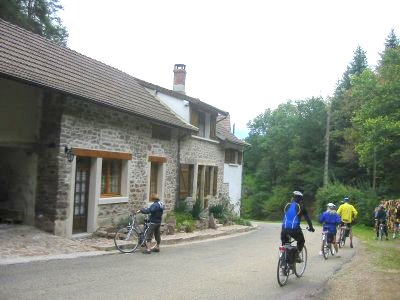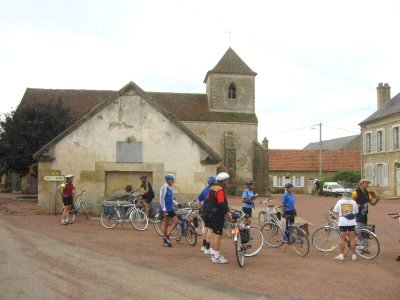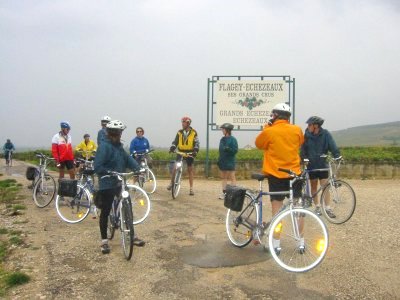France Adventure, Page 2
Pictures and Stories About Bicycle Adventures

Bourgogne Region, France,
By Bicycle, Sep 28 - Oct 9, 2003


Above Left: Day 4.
Above Right: heading into Vallée du Cousin through the French National Park Morvan, heading for Basilique Sante-Madelein, Vezelay. Sante is French for a female saint. Madelein as in Mary Magdalen (or three other spelling versions). I begin to notice the word Templar or sometimes Knight Templar or I notice Maltese Cross symbols every now and then. I'm not smart enough to take a picture of these things, yet


Above Left: We are crossing under and over bridge structures that are over a hundred years old. There is virtually no traffic and we seem to have the world pretty much to ourselves.
Above Right: A picture of Terry at the Hostellerie du Moulin des Ruats (Fashionable Country Inn of the Mill of Ruats). Her blouse matches the flower colors around us, I tell her after I take the picture.


Above Left: This is a picture of the front of the Mill Inn. There actually is a water wheel in the back, long since disconnected. The dwelling is covered in Ivy, surrounded by flowering plants or shrubs.
Above Right: Onward and forward. We stop, as a group, at another village center. One of the fellow riders recognizes the structure in the immediate foreground as an old Roman style water distribution facility.


Above Left: A closer look at the water house: An old well is covered by a stone block adjacent to a newer styled centrifugal water wheel pump. The water system delivered water to a gravity driven trough that would deliver clean water, first for human consumption (an outside basin on one side of the structure), and then split between a wash house (on the inside) and the animal trough (on the outside, opposite the human use area). There is some earnest hydraulic engineering involved in the distribution network. We're glad that all of this is pointed out to us and the rest of the group.
Above Right: This is the roof structure of the water house.


Above Left: We have arrived at our lunch location, on the Cousin River. Just at the end of the upper bridge is the Village of Pierre Pertuis. There are two bridges. The lower bridge (the bridge in the center of the picture) was built by the Romans. The upper bridge (parts of one support arch visible in the upper center background) was a more recent bridge construction. It is a 1770 Arch Bridge. We have lunch here. Phillipe introduces us to some Bourgogne Grand Cru wines.
Above Right: Terry and Dennis sitting on a Roman built bridge at Pierre Pertuis, the Cousin River in the background.


Above Left: We are arriving into the village of St Pere. This village is at the foot of Basilique Sante-Madelein, Vezelay.
Above Right: A view of Basilique Sante-Madelein, Vezelay from St Pere. All that we bicyclists have to do is ride our bikes up the hill. Vezelay means "Eternal Hill." Saint Bernard called for and initated the second Crusade from this location. Also a couple more Crusades were initiated from this location.


Above Left: The Shell became a symbol for Pilgrimage trail. Apparently pilgrimages were involved and intricate and probably very formalized over time. Shell symbols were distributed to key locations to help pilgrims stay on the correct course and maybe their was some commercial value to having a shell placed near a person's place of business.
Above Right: Basilique Sante-Madelein, side hall.


Above Left: The entrance arch relief art work for the Basilique Sante-Madelein, Vezelay. The Basilique claims to have relics of Mary Magdalen - They were not on display or well publicized, nor does anyone explain how the relics came to exist. In any case, the church, its gardens, and view are beautiful.
Above Right: One of the many Cure Valley views from the hill top of Vezelay.


Above Left: Day 5. The day starts with a visit to the 12th Century Cistercian Abbaye de Fontenay. This abbey is one of the oldest and best preserved monasteries in France and their monks were known for their iron work. There were many tourists and few bathrooms. It takes planning and skill to get pictures without hoards of people. The roof of this dorm is purposefully designed to imitate a boat hull.
Above Right: Directly from the abbey, we start biking the Canal de Bourgogne and its 37 locks. The locks are numbered, so it is easy to track our progress. Again, we have the world to ourselves. Our group leader (Karl) and guide (Marie) are determining our Lunch time rendezvous with our logistician (Philippe).


Above Left: An overview of one of the many locks of the Canal de Bourgogne.
Above Right: Lunch: Quiche Lorraine, made by Phillipe's wife Christiane, plus fromage, breads, cuts of meat, and Vins de Bourgogne. Life is Good.


Above Left: After lunch, we biked to Semur en Auxois. It is a popular French travel-tourist destination for wine, antiques, and art.
Above Right: The Hotel Cote D'Or is across the avenue from the begining of the long bazar of shops at Semur en Auxois.


Above Left: Its just an interesting sign.
Above Right: The bike gang meets on a main bridge (Pont Joly) over the River Armançon in Semur en Auxois to celebrate our journey in France. Our fearless leader (Karl, in yellow) is helping Philippe (Logistician - far right) and Marie (Guide, lady, middle) set up the bread, vin, and fromage of the regional cuisine.


Above Left: Day 6. Its Saturday morning at the Beaune Town Center. Life will be fast and furious until about noon, then shopping and errands end and weekend leisure's begin (if not already). Getting out on the towns square is part of the social life. We are here to visit the famous Hôtel-Dieu whose entrance is pictured to the right. The Hôtel-Dieu is one of two hospitals that form the Hospices de Beaune. The other hospital is Hospice de la Charité.
Above Right: The portico entrance for the Hôtel-Dieu is an architectural trademark for both the town of Beaune and its Hospice (French concept and term that evolved to become Hospital)- it is supported from only one side. It is very ornate. Some of the wines from this area use this porticol as a label symbol. More about this hospice in the next paragraph.


Above Left: Pictured is the interior court and some of the world famous tiled roof design. The Hospice Hôtel-Dieu started as a care center for the sick or injured that primarily resulted from France's participation in the 100 Years War. The hospice started as Hôtel Dieu in 1443, created by Nicolas Rolin (Chancellor to Duke Philip). Later, in the 1800's, the hospice merged with the Hospice de la Charité and the property holding were later converted to a community trust, such that hundreds of acres of world class vineyard wines, whose land is owned by the hospices, are auctioned annually and the proceeds still go to local hospital welfare.
Above Right: We started biking from the Beaune locale, heading to Dijon, and stopped in front of this sign for the Flagey-Echezeaux Grand Crus. The weather is perfect for biking as long as we don't stop too long - its cool and just slightly moist. We're all in rain gear. We can't turn in any direction without running into world class grand crus vineyards. We are in the heart of the Bourgogne Grand Crus.


Above Left: The gate for Clos Blanc de Vaougeot. Yum!
Above Right: We stop for lunch, esqisitely provided by Philippe, and a tasting of Beaune's Wines. We're all thirsty for some reason.


Above Left: The grapes of Morey-St Denis. It turns out that Morey-St Denis (pinot noir) wine is the favorite of Pope John-Paul [who was living at the time of this photograph]. We learned that Pontif means "bridge builder."
Above Right: Group Photo at the sign for the
Latricieres Chambertin (Cote Nuit). Good grapes, good people, perfect sized group, plan, and tour! We, Terry and Dennis, are standing on the wall on the viewer's upper right -- Team Green (arh arh).

Above: We arrived into Dijon, France. The mustard capitol, as in Grey Poupon. The bear is called "Pom Pom" and is a locally loved symbol of Dijon. The bear statue was actually created by Francois Pompom (1855-1933), a French sculptor and student of Rodin. Pompom is famous for his stylized animal figures and the white bear (Ours Blanc) is a signature piece.
|

|
|
|
|
Above Right: Dijon Story One: Maurice Grey teamed with Antoine Poupon and opened a store in 1777. Pictured is the very same store. The pleasurably palatable Dijon Mustard process that we know today was created in 1859 by Jean Naigeon. The process includes mixing sour unripened grape juice with the local mustard pulp. The Grape Juice counter balanced the acid of the mustard. It is, some how, only fitting that wine grapes from the region of Bourgogne would be the solution to a spice epicurean issue in France.
Dijon Story Two: I always thought that the French name Cote d'Or meant Hills (or Slopes) of Gold (a literal dictionary translation). But going back in history a little, in 1404 Philip the Bold created a religious order called the "Order of the Golden Fleece" and supposedly the French term Cote d'Or actually means Golden Fleece. The Order was supposedly created to better Philip's and Burgundy's position with the church (Holy Roman Empire) and not be out positioned by the English within the church.
|


Above Left: Dijon has burned down and been rebuilt a few times over the centuries, but some parts are just as they were created, centuries ago. We happen to be on a well preserved part of Dijon that reflects the architectures of the period, over time. This is thirteenth century construction. A person could walk from here towards the town center and watch the building style and architecture change and progress over time to the current era. We jokingly referred to this as the entrance to "Daigon Alley" (Harry Potter - wink).
Above Right: Just a little curiosity shop in Daigon Alley -- I mean Dijon Alley. There is even a Black Cat statue mounted on the roof!
Previous
Top
Next
|



































